Timeline of solar power
This is a timeline of solar power, listing imporant events in the development of technologies harnessing solar power.
Big picture
| Time period | Development summary |
|---|---|
| Ancient history | Humans are known to have used solar power since ancient times. In the Roman Empire, solar architecture was used to heat bathhouses. Humans have also been concentrating the sun’s energy with mirrors or magnifying glasses for more than 1,300 years.[1] |
| 19th century | Solar power technology begins after Edmond Becquerel discovers that some materials produce electricity when exposed to light. William Grylls Adams and his student use selenium to create electricity from light, creating the world’s first photovoltaic power source.[1] |
| 20th century | The era of modern solar cell technology begins in the 1950s when G.L. Pearson, D. Shapin and C. Fuller demonstrate a silicon solar cell capable of 6% energy conversion efficiency with direct sunlight.[2][3] In the 1970s, as oil prices rise, demand for solar power increases, and research drives costs down.[4] By the early 1990s, solar technology enters a truly marketable level of efficiency.[1] |
| 21st century | As of 2017, global solar photovoltaic power generating capacity rose to nearly 400 gigawatts by year-end, a 32% increase versus the end of 2016. Capacity has nearly quadrupled in the past five years. China is the major producer. Other important producers of are United States, Japan, Germany and Italy.[5] |
Full timeline
| Year | Event type | Details | Location |
|---|---|---|---|
| 7th century BC | Solar energy already used by humans in the 7th century B.C. in the form of using sunlight to light fires with magnifying glass materials.[6] | ||
| 3rd century BC | Greeks and Romans are known to harness solar power with mirrors to light torches for religious ceremonies. These mirrors become a normalized tool referred to as “burning mirrors.”[6] | ||
| 20 AD | The Chinese civilization documents the use of mirrors for the same purpose like those used by Greeks and Romans.[6] | China | |
| Late 1700s – 1800s | Researchers and scientists have success using sunlight to power ovens for long voyages. They also harness the power of the sun to produce solar-powered steam boats.[6] | ||
| 1839 | French physicist Edmond Becquerel first discovers the photovoltaic effect. This process occurs when light is absorbed by a material and creates electrical voltage. Most modern solar cells use silicon crystals to attain this effect.[4][7] | France | |
| 1873 | Scientific development | English electrical engineer Willoughby Smith discovers that selenium has photoconductive potential.[8][9][10][6][4] | United Kingdom |
| 1876 | Scientific development | British physicist William Grylls Adams and Richard Evans Day discover that selenium creates electricity when exposed to sunlight.[6][3] | |
| 1877 | Literature | American scientists William Adams and Richard Day publish The action of light on selenium.[11] | United States |
| 1883 | Technology | American inventor Charles Fritts produces the first solar cells made from selenium wafers.[6] Fritts coats selenium with a thin layer of gold. This cell achieves an energy conversion rate of 1–2% (most modern solar cells work at an efficiency of 15–20%).[4] | United States |
| 1887 | Scientific development | German physicist Heinrich Hertz first observes the photoelectric effect, where light is used to free electrons from a solid surface (usually metal) to create power. Hertz finds this process produces more power when exposed to ultraviolet light, rather than more intense visible light. Albert Einstein later receives the Nobel Prize for further explaining the effect. Modern-day solar cells rely on the photoelectric effect to convert sunlight into power.[4] | Germany |
| 1888 | Technology | American chemist Edward Weston receives the first US Patent for solar cell.[11] | United States |
| 1888 – 1891 | Technology | Russian physicist Aleksandr Stoletov develops the first solar cell using the outer photoelectric effect.[11] | |
| 1902 | Scientific development | German physicist Philipp Lenard observes that the energy of individual emitted electrons increases with the frequency (which is related to the colour) of the light.[12] | Germany |
| 1904 | Technology | German physicist Wilhelm Hallwachs develops a semiconductor-junction solar cell.[11] | Germany |
| 1905 | Scientific development | Albert Einstein publishes his theory of “photoelectric effect”.[11] | |
| 1914 | Scientific development | American scientists Goldman and Brodsky become the first to correlate the photoelectric effect with the existence of a barrier to current flow at a semiconductor-metal interface. This work proves to be a key insight to building practical photovoltaic devices.[13] | United States |
| 1918 | Technology | Polish chemist Jan Czochralski invents the Czochralski process, which is used for growing single crystals and in the production of semiconductor wafers.[14][15][16] | Germany |
| 1922 | Albert Einstein receives Nobel Prizes in Physics for his photoelectric effect theory.[11] | ||
| 1932 | Scientific development | Stora and Audobert discover cadmium selenide, a photovoltaic material.[11][13] | |
| 1941 | Technology | American engineer Russell Ohl invents the solar cell, shortly after the invention of the transistor.[2][17][18][7] | United States |
| 1954 | Technology | Daryl Chapin, Calvin Fuller, and Gerald Pearson at Bell Labs create the silicon photovoltaic (PV) cell. Many argue that this event marks the true invention of PV technology because it is the first instance of a solar technology that could actually power an electric device for several hours of a day.[6] | United States |
| 1956 | Technology | American company Western Electric begins selling commercial licenses for its silicon PV technologies. However, the prohibitive costs of silicon solar cells keep them from widespread market saturation.[4] | United States |
| 1956 | Cost | Solar panels cost roughly US$300 per watt.[6] | |
| 1957 – 1960 | Technology | Hoffman Electronics makes a number of breakthroughs with photovoltaic efficiency, improving the efficiency record from 8% to 14%.[6] | |
| 1958 | Solar energy is used in space. The Vanguard I satellite uses a tiny one-watt panel to power its radios. Later that year the Vanguard II, Explorer 3 and Sputnik 3 are all launched with PV technology on board.[6][4][4] | ||
| 1959 | Technology | Hoffman Electronics achieves 10% efficient, commercially available PV cells and demonstrates the use of a grid contact to significantly reduce series resistance.[13] | |
| 1960 | Technology | Hoffman Electronics develops a new solar cell with fourteen percent efficiency.[11][19][20][21] | |
| 1960 | Technology | The idea of bifacial photovoltaic modules is independently developed by Japanese scientist H. Mori and Russian scientists A.K. Zaitseva and O.P. Fedoseeva. These bifacial photovoltaic modules have two active surfaces and thus have the potencial to generate more electric energy with roughly the same size collector.[13] | |
| 1961 | Technology | American physicist William Shockley and German physicist Hans-Joachim Queisser become the first to define the maximum theoretical efficiency of a solar cell using a single p–n junction to collect electricity from the cell. The Shockley-Queisser limit is fundamental to direct solar energy conversion.[13] | |
| 1961 | The Institute of Electrical and Electronics Engineers (IEEE) holds its first specialty conference on photovoltaic energy in Philadelphia.[13] | United States | |
| 1963 | Technology | Japanese multinational Sharp Corporation manufactures a feasible photovoltaic module of silicon solar cells.[11] | |
| 1964 | Technology | NASA launches the first Nimbus spacecraft, a satellite able to run entirely on a 470 watt solar array.[6][22][23] | United States |
| 1964 | Literature | American physical chemist Farrington Daniels publishes Direct Use of the Sun's Energy.[24] | United States |
| 1966 | Technology | NASA launches the world’s first Orbiting Astronomical Observatory, powered by a one-kilowatt array.[6] | |
| 1967 | Technology | Russian Soyuz 1 becomes the first manned spacecraft to be powered by solar cells.[13] | |
| 1968 | Technology | Robert Riehl introduces his solar-powered wristwatch.[25] | |
| 1968 | Czechoslovakian-born American scientist Peter Glaser presents the concept for the Solar power Satellite (SPS) system to supply power from space for use on Earth.[13] | United States | |
| 1970 | Technology | Soviet team led by Zhores Alferov develops the first highly effective GaAs heterostructure solar cells.[26][27][28][29] | Soviet Union |
| 1973 | Technology | The University of Delaware constructs the first solar building, named “Solar One.” The system runs on a hybrid supply of solar thermal and solar PV power. It is also the first instance of building integrated photovoltaics (BIPV).[6][30][31] | United States |
| 1974 | Organization | The National Renewable Energy Laboratory (NREL) is established in the United States.[32][33] | United States |
| 1974 | Program | Japan launches the "Project Sunshine", a broad R&D program in solar energy. The goal is to produce new sources of clean energy by the year 2000.[34][35][36] | Japan |
| 1975 | Cost | Solar panels cost drops to just over US$100 a watt.[6] | |
| 1975 | Organization | The Florida Solar Energy Center (FSEC) is established as the state's energy research institute. FSEC later becomes a world leader in solar energy research.[13] | United States |
| 1976 | Technology | The idea of fluorescent photovoltaic cell is independently developed by German scientists Adolf Goetzberger and W. Greubel, and W.H. Weber and J. Lamb.[13] | |
| 1976 | Technology | American engineers David Carlson and Christopher R. Wronski invent the hydrogenated amorphous silicon solar cell.[13] | United States |
| 1978 | Technology | The first solar-powered calculator is released.[37][38][39][40] | |
| 1979 | United States President Jimmy Carter has solar panels installed on the White House during his term as president.[6] | United States | |
| 1980< | Cost | Solar panel prices starts dropping by at least 10 percent every single year. The plummeting cost of solar is largely responsible for the growing popularity of solar and the legitimacy of photovoltaics as a reliable energy source in today’s world.[6] | |
| 1981 | Paul MacCready builds Solar Challenger, the first aircraft to run on solar power, and flies it across the English Channel from France to Britain.[6] | ||
| 1982 | Facility | Arco Solar builds the first solar park (basically a solar power plant) in Hesperia, California.[4] | United States |
| 1985 | Technology | The University of South Wales achieves 20% photovoltaic efficiency for silicon cells.[6] | Australia |
| 1985 | Organization | SunPower Corporation is established by Richard Swanson to develop and commercialize cost-effective, high-efficiency photovoltaic power systems based on the "all-back contact" cell design.[13] | United States |
| 1986 | Technology | ARCO Solar releases the G-4000, the world's first commercial thin-film photovoltaic module.[13] | |
| 1989 | Technology | Reflective solar concentrators are first applied with solar cells.[11] | |
| 1991 | Technology | The first efficient photo electrochemical cell and the dye-sensitized solar cell are developed.[11] | |
| 1992 | Technology | The University of South Florida creates a 15.89 percent efficient thin-film cell.[11] | United States |
| 1994 | Technology | The U.S. National Renewable Energy Laboratory develops a new solar cell from gallium indium phosphide and gallium arsenide that exceeds 30% conversion efficiency.[4] | United States |
| 1994 | Program | Japan starts “70,000 Solar Roofs” PV subsidy program, to increase the use of photovoltaic system in the residential sector.[41][42][43] | Japan |
| 1995 | Technology | Thomas Faludy files a patent for a retractable awning with integrated solar cells. This is one of the first times solar cells are used in recreational vehicles. Later, this feature would become a popular way to power RVs.[4] | |
| 1998 | Technology | The remote-controlled solar airplane “Pathfinder” sets an altitude record after reaching 80,000 feet.[6][44][45][46] | |
| 1999 | Technology | The U.S. National Renewable Energy Laboratory creates thin-film solar cells that convert 32% of the sunlight it collects into usable energy.[6][4] | United States |
| 2000 | Technology | Sandia Laboratories invents the modern inverter, which converts the direct current (DC) produced by solar panels to alternating current (AC), the standard for homes in the United States.[1] | United States |
| 2001 | NASA breaks record when reaching 96,000 feet with its solar-powered non-rocket aircraft.[6] | ||
| 2005 | Technology | DIY solar panels are released. These would become more prevalent with each new year.[4][3] | |
| 2006 | Technology | Solar cell surpass the 40 percent efficiency.[11] | |
| 2007 | Program | Google launches in the United States the Project Sunroof, with aim at helping homeowners explore whether they should go solar, offering solar estimates for over 43 million houses across 42 states.[47][48][49] | United States |
| 2008 | Technology | The inverted metamorphic triple-junction solar cell is developed.[11] | |
| 2015 | Technology | Solar cells as thin as paper are manufactured using an industrial printer. These have 20% power conversion efficiency, and a single strip can produce up to 50 watts per square meter.[4] | |
| 2016 | Technology | Researchers at the University of South Wales reach 34.5% photovoltaic efficiency.[6] | Australia |
| 2016 | Bertrand Piccard completes the first zero-emissions flight around the world with Solar Impulse 2, the world’s largest and most powerful solar-powered airplane to date.[6] | ||
| 2016 | Scientific development | A research team from the University of California, Berkeley, and the Australian National University discover nanomaterial property called magnetic hyperbolic dispersion, which means the material glows when heated. If combined with thermophotovoltaic cells, it could turn heat into electricity without the need for sunlight.[4] | United States, Australia |
Numerical and visual data
Google Scholar
The following table summarizes per-year mentions on Google Scholar as of October 28, 2021.
| Year | "solar power" |
|---|---|
| 1900 | 6 |
| 1910 | 1 |
| 1920 | 3 |
| 1930 | 3 |
| 1940 | 3 |
| 1950 | 6 |
| 1960 | 92 |
| 1970 | 156 |
| 1980 | 2,110 |
| 1990 | 1,090 |
| 2000 | 2,660 |
| 2010 | 13,400 |
| 2020 | 31,800 |
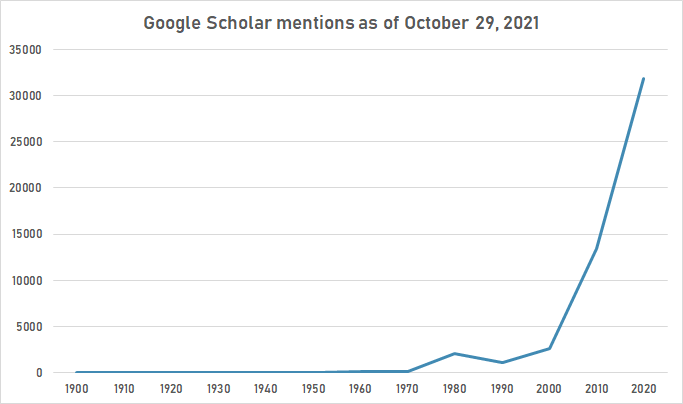
Google Trends
The comparative chart below shows Google Trends data for Solar power (Topic), Nuclear power (Topic), Wind power (Topic) and Hydroelectricity (Topic), from January 2004 to April 2021, when the screenshot was taken. Interest is also ranked by country and displayed on world map.[50]
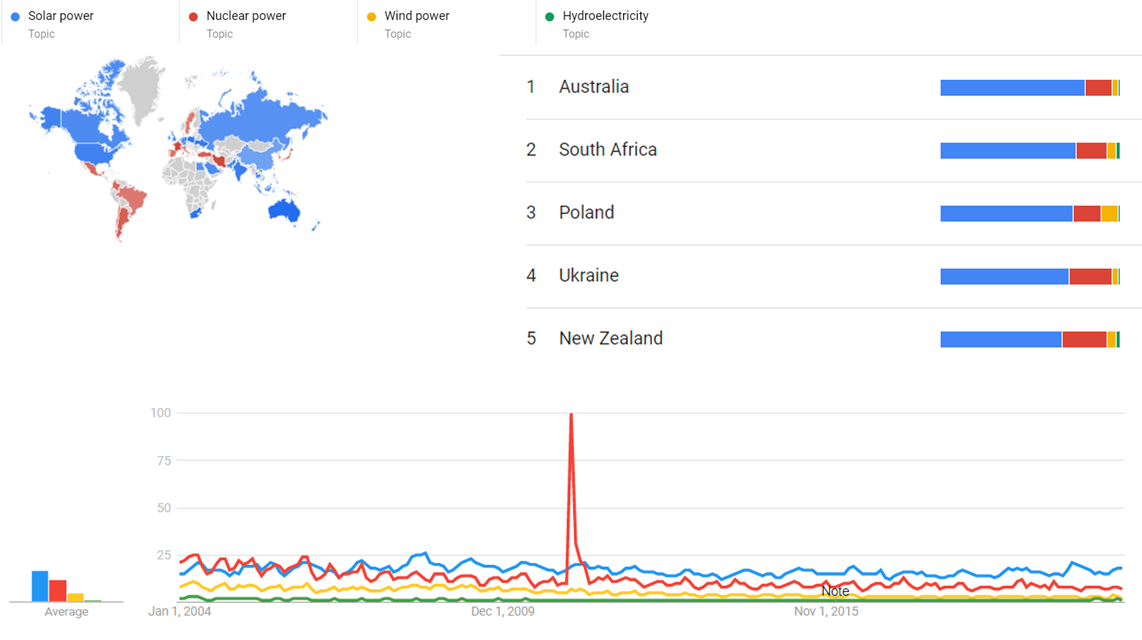
Google Ngram Viewer
The comparative chart below shows Google Ngram Viewer data for Solar power, Nuclear power, Wind power, Coal -fired power and Hydroelectricity, from 1900 to 2019.[51]
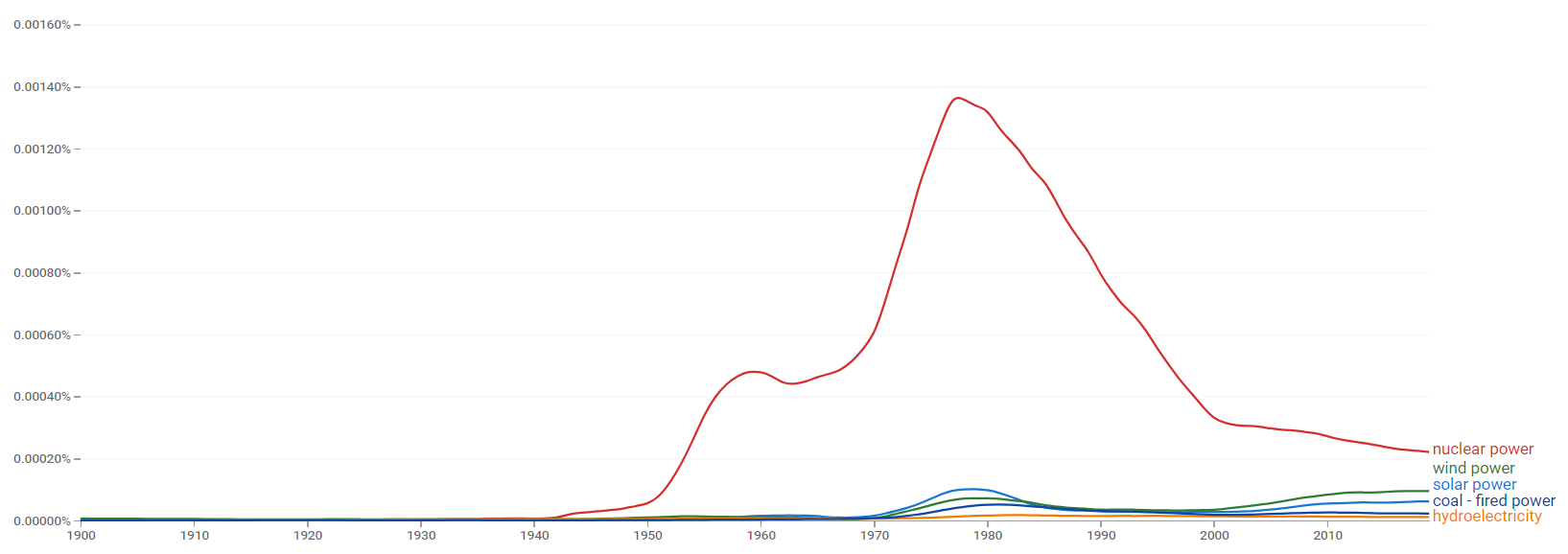
Wikipedia Views
Note: Data gaps observed on desktop from October 2014 to June 2015 are the result of Wikipedia Views failure to retrieve data.
The chart below shows pageviews of the English Wikipedia article Solar power, on desktop from December 2007, and on mobile-web, desktop-spider, mobile-web-spider and mobile app, from July 2015; to March 2021.[52]
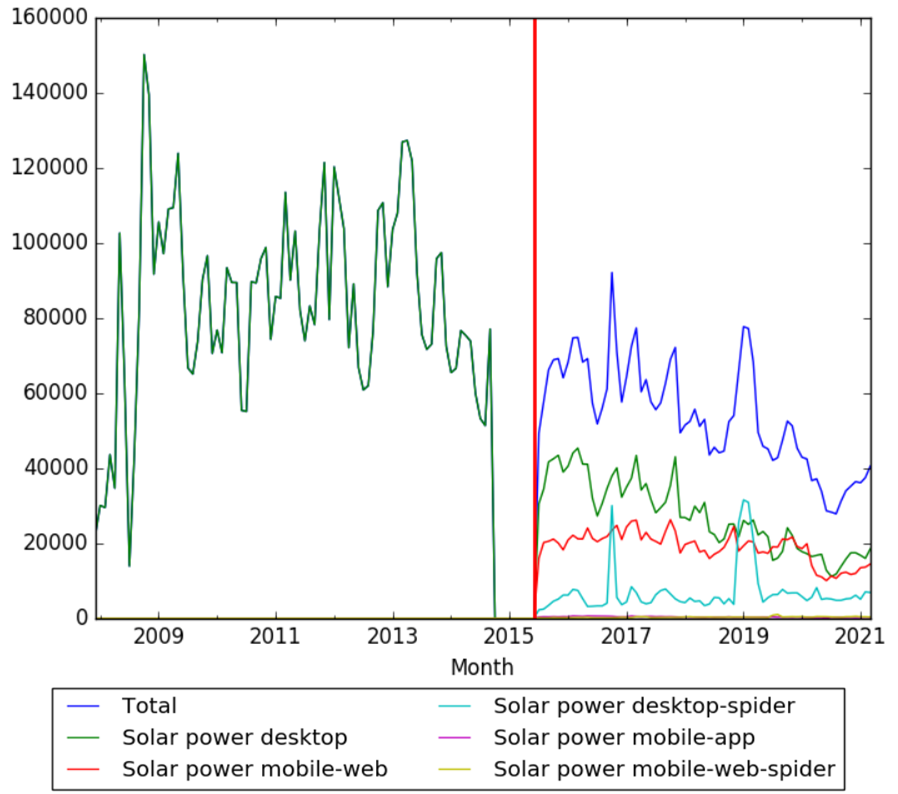
The comparative chart below shows pageviews on desktop of the English Wikipedia articles Solar power, Nuclear power, Wind power and Hydroelectricity (Topic) from December 2007 to March 2021.[53]
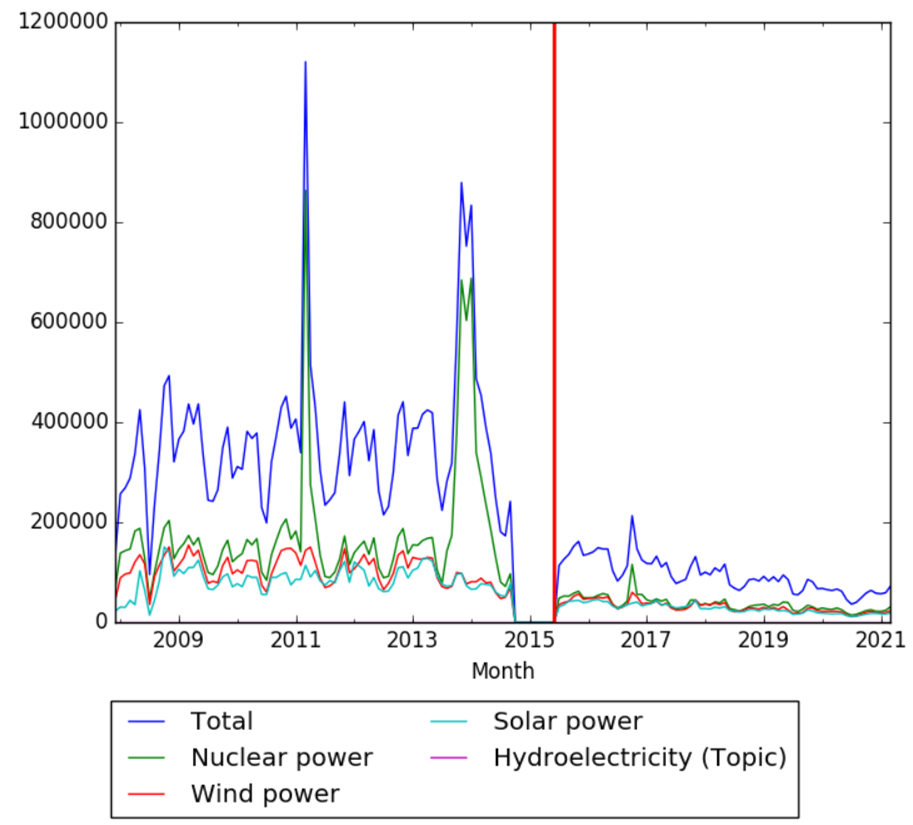
Meta information on the timeline
How the timeline was built
The initial version of the timeline was written by User:Sebastian.
Funding information for this timeline is available.
Feedback and comments
Feedback for the timeline can be provided at the following places:
- FIXME
What the timeline is still missing
Timeline update strategy
See also
External links
References
- ↑ 1.0 1.1 1.2 1.3 "How Solar Power Has Improved Over Time". solarpowerauthority.com. Retrieved 26 September 2018.
- ↑ 2.0 2.1 Light, Water, Hydrogen: The Solar Generation of Hydrogen by Water Photoelectrolysis (CRAIG GRIMES, OOMMAN VARGHESE, SUDHIR RANJAN ed.).
- ↑ 3.0 3.1 3.2 "A Brief History of Photovoltaics and Solar Energy". empirecleanenergy.com. Retrieved 15 September 2018.
- ↑ 4.00 4.01 4.02 4.03 4.04 4.05 4.06 4.07 4.08 4.09 4.10 4.11 4.12 4.13 4.14 "A History of Solar Cells: How Technology Has Evolved". solarpowerauthority.com. Retrieved 23 August 2018.
- ↑ "Solar energy". bp.com. Retrieved 1 October 2018.
- ↑ 6.00 6.01 6.02 6.03 6.04 6.05 6.06 6.07 6.08 6.09 6.10 6.11 6.12 6.13 6.14 6.15 6.16 6.17 6.18 6.19 6.20 6.21 6.22 6.23 "What is the history of solar power and when were solar panels invented?". news.energysage.com. Retrieved 23 August 2018.
- ↑ 7.0 7.1 "SOLAR PANEL BRIEF HISTORY AND OVERVIEW". energymatters.com.au. Retrieved 24 August 2018.
- ↑ Singh, Jai; Williams, Richard T. Excitonic and Photonic Processes in Materials.
- ↑ Hempstead, Colin; Worthington, William. Encyclopedia of 20th-Century Technology.
- ↑ McLean, Donald F. Restoring Baird's Image.
- ↑ 11.00 11.01 11.02 11.03 11.04 11.05 11.06 11.07 11.08 11.09 11.10 11.11 11.12 11.13 "Photovoltaic History: A Timeline of Important Breakthroughs". dbmsolar.com. Retrieved 24 August 2018.
- ↑ "Photoelectric Effect". myexistenz.com. Retrieved 24 August 2018.
- ↑ 13.00 13.01 13.02 13.03 13.04 13.05 13.06 13.07 13.08 13.09 13.10 13.11 13.12 Cleveland, Cutler J.; Morris, Christopher G. Handbook of Energy: Chronologies, Top Ten Lists, and Word Clouds.
- ↑ Nishinaga, Tatau. Handbook of Crystal Growth: Fundamentals.
- ↑ Shing, Lau Wai. Ulsi Front-end Technology: Covering From The First Semiconductor Paper To Cmos Finfet Technology.
- ↑ Nemova, Galina. Laser Cooling: Fundamental Properties and Applications.
- ↑ Thomas, Isabel. The Pros and Cons of Solar Power.
- ↑ Flinn, Elizabeth; Patel, Sarah. The Really Useful Primary Design and Technology Book: Subject knowledge and lesson ideas.
- ↑ Powering Our Future: An Energy Sourcebook for Sustainable Living. Kimberly K. Smith, Alternative Energy Institute.
- ↑ "Is New Solar Power Technology on the Horizon? Should You Buy Now?". capitalcitysolar.com. Retrieved 15 September 2018.
- ↑ "A Brief History of Everything Solar". cleantechnica.com. Retrieved 15 September 2018.
- ↑ "Why China, and not the US, is the leader in solar power". aljazeera.com. Retrieved 15 September 2018.
- ↑ "Solar Does It – From Eureka Moments to Wacky Wearables". Retrieved 15 September 2018.
- ↑ "Direct Use of The Sun's Energy By Farrington Daniels. Illustrated. 374 pp. New York: Ballantine Books. $1.95". nytimes.com. Retrieved 24 August 2018.
- ↑ "The Story of Roger W. Riehl and the Synchronar". watchesnsuch.net. Retrieved 24 August 2018.
- ↑ "Optical Spectrocopy on Nanostructrured Materials" (PDF). diva-portal.org. Retrieved 24 August 2018.
- ↑ Palz, Wolfgang. The Triumph of the Sun: The Energy of the New Century.
- ↑ Madou, Marc J. From MEMS to Bio-MEMS and Bio-NEMS: Manufacturing Techniques and Applications.
- ↑ Palz, Wolfgang. The Triumph of the Sun: The Energy of the New Century.
- ↑ "University of Delaware Builds Solar-Powered Residence'". historycommons.org. Retrieved 28 September 2018.
- ↑ "Karl Wolfgang Böer Papers". lib.udel.edu. Retrieved 28 September 2018.
- ↑ Rimmer, Matthew. Intellectual Property and Climate Change: Inventing Clean Technologies.
- ↑ Schilling, Vincent. Native Defenders of The Enviornment.
- ↑ Characterization and Assessment of Potential European and Japanese Competition in Photovoltaics. Department of Energy, Solar Energy Research Institute, 1979.
- ↑ Jones, Geoffrey. Profits and Sustainability: A History of Green Entrepreneurship.
- ↑ Jones, Geoffrey. Varieties of Green Business: Industries, Nations and Time.
- ↑ Grinnell, Scott. Renewable Energy & Sustainable Design.
- ↑ Fraas, Lewis M. Low-Cost Solar Electric Power.
- ↑ Robbins, Michael W. Whole Green Catalog: 1000 Best Things for You and the Earth.
- ↑ "Featured Electronic Hand-held Calculators". vintagecalculators.com. Retrieved 24 August 2018.
- ↑ Jordan-Korte, Katrin. Government Promotion of Renewable Energy Technologies: Policy Approaches and Market Development in Germany, the United States, and Japan.
- ↑ Fthenakis, Vasilis M.; Lynn, Paul A. Electricity from Sunlight: Photovoltaic-Systems Integration and Sustainability.
- ↑ Herbes, Carsten; Friege, Christian. Marketing Renewable Energy: Concepts, Business Models and Cases.
- ↑ "Pathfinder-Plus Solar Aircraft Lands in Smithsonian". nasa.gov. Retrieved 28 September 2018.
- ↑ "SOLAR-POWERED PATHFINDER-PLUS HITS NEW UNOFFICIAL ALTITUDE RECORD". nasa.gov. Retrieved 28 September 2018.
- ↑ "AeroVironment's Pathfinder Solar Unmanned Aircraft Lands in Smithsonian Institution". investor.avinc.com. Retrieved 28 September 2018.
- ↑ "Google launches Project Sunroof to suggest the best solar panel installation for your home". venturebeat.com. Retrieved 15 September 2018.
- ↑ "Project Sunroof: Solar energy sustainability with Google". deccanchronicle.com. Retrieved 15 September 2018.
- ↑ "Google's Project Sunroof: How it could help you save with solar power". csmonitor.com. Retrieved 15 September 2018.
- ↑ "Solar power, Nuclear power, Wind power and Hydroelectricity". Google Trends. Retrieved 14 April 2021.
- ↑ "Solar power, Nuclear power, Wind power, Coal -fired power and Hydroelectricity". books.google.com. Retrieved 20 April 2021.
- ↑ "Solar power". wikipediaviews.org. Retrieved 20 April 2021.
- ↑ "Solar power, Nuclear power, Wind power and Hydroelectricity (Topic)". wikipediaviews.org. Retrieved 20 April 2021.